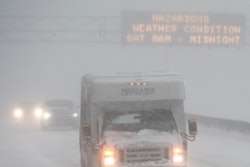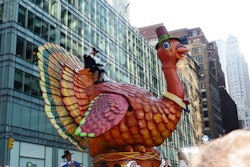
Winter trucking in Pennsylvania ought to be less uncertain and restrictive than it was a year ago.
The commonwealth has a new draft process in place for when and how it will restrict vehicles — especially trucks — during snowstorms and other bad weather. It also has a new way to inform truckers of those restrictions.
The state’s trucking industry, while optimistic, is also waiting to see how things go one serious winter weather arrives.
In short, when heavy snows, high winds, and/or freezing rain descend on Pennsylvania this winter, truckers will need to slow down and stick to the right lane. They will also have a fair warning in advance of when they need to do so, and when further, more restrictive measures are put in place.
That’s the heart of a policy the Pennsylvania Department of Transportation and its partners will follow this winter in efforts to keep travelers safe, and also keep trucks moving. The draft policy comes on the heels of numerous complaints a year ago that limited or banned truck travel numerous times, and saw police issuing violations — 827 during one particularly brutal February storm — that cost as much as $300.
Alexis Campbell, PennDOT’s press secretary last week said the agency worked for the past several months with the Pennsylvania Emergency Management Agency, the Turnpike Commission and the State Police to formulate the draft framework for handling winter weather travel restrictions. In place is a five-tiered process that restricts travel by vehicles based on the severity of the weather and highway conditions. Tier One limits travel by certain kinds of vehicles, including some trucks, while Tier Five is a complete travel ban for almost all.
Trucks exempt from travel restrictions are those of public utilities restoring essential services, fire, and other emergency services, tow trucks and trucks making emergency deliveries of liquid fuels such as fuel oil, gasoline, and propane.
Kevin Stewart is the president of the 1,400-member Pennsylvania Motor Truck Association and said his organization had requested the inclusion of the “45 mph and stay in the right lane” provision. Stewart said he shared PennDOT’s travel restriction guidelines with the group’s board of directors who he said expressed both optimism and caution.
“This is better than last year,” said Stewart. “But the proof will be in the pudding of how this works out this winter.”
Stewart also said PennDOT agreed to have a separate page on 511PA dedicated to commercial vehicles where restrictions on trucks could be posted and on social media outlets before they are put into effect. Last year, said Stewart, restrictions were in effect as soon as they were announced and truckers often had little if any warning.
The plan “will remain in draft format until we see how the procedures work for this winter weather season; the draft can be updated as necessary if needed as we look at incident statistics and data after each incident,” according to Campbell.
She added, “Whenever restrictions are initiated, we communicate them to the industry as soon as we can so they can plan accordingly. We are also as flexible as possible with implementing restrictions based on the weather, including delaying implementation and adjusting which roadways are impacted as well as removing restrictions as soon as we can safely do so. We tailor the restrictions based on forecasts, so we use a mix of full commercial restrictions and restrictions on only certain types of vehicles.”
The decision to enact restrictions is made collaboratively between PennDOT, State Police, PEMA, the PA Turnpike Commission. She said PennDOT, the state police and PEMA review CMV restrictions hourly once they have been initiated to determine if the conditions warrant the ban or if it can be lifted.
Campbell said Pennsylvania will also continue to coordinate with neighboring states to minimize traffic impacts at the borders as much as possible. Campbell cited as an example that Pennsylvania may keep some of its restrictions in place longer because New Jersey still has its in place and CMVs and others may be traveling out of Pennsylvania and into New Jersey.
Previously, Campbell said,“Ultimately our goal is we need to keep people safe and we need to keep the public safe and we want to keep CMV drivers safe too. When we implement restrictions we don’t have big crashes that close interstates down. When there’s a CMV crash, it’s a bigger deal. Roadways can be blocked, there could be hazmat cleanup, all sorts of things can get more complicated.”
PennDOT’s James May last week told WNEP-TV, “We’re hoping it’s a good compromise where they can still keep moving. They can still be out there and make a living and keep the commerce going but also do so that is safe for the public.”
PennDOT plows more than 94,000 miles of snow lanes — over 40,000 miles of highways in both directions, plus on/off ramps and other surfaces — this winter.
The five tiers of weather-related travel restrictions include:
Tier 1
• Tractors without trailers
• Tractors towing unloaded or lightly loaded enclosed trailers, open trailers or tank trailers. A lightly loaded CMV is defined as a vehicle that is less than 1/3rd of the GVWR (vehicle weight and cargo weight combined).
• Tractors towing unloaded or lightly loaded tandem trailers
• Enclosed cargo delivery trucks that meet the definition of a CMV
• Passenger vehicles (cars, SUV’s, pick-up trucks, etc.) towing trailers, to include Recreational travel trailers and fifth-wheel trailers; enclosed cargo trailers; open cargo trailers; vehicle transport trailers
• Recreational vehicles/motorhomes
• School buses, commercial buses, and motor coaches
• Motorcycles
Tier 2
Tier 1, plus all CMV’s towing loaded tandem trailers
Tier 3
Tier 1 and 2, plus all loaded CMV’s except for those carrying full coverage tire chains for at least two drive wheels, or those with approved alternate traction devices (ATDs). Tire chains do not need to be installed, but need to be readily available for use should the vehicle become stuck and not be able to move because of poor traction.
Tier 4
Tier 1, 2, and 3, plus all CMV’s regardless of loading or availability of tire chains or approved alternate traction devices. This is referred to as a complete CMV ban.
Tier 5
Tier 1, 2, 3, and 4, plus all passenger vehicles
___
David Hollis editor of Truckers News and can be reached at [email protected]












